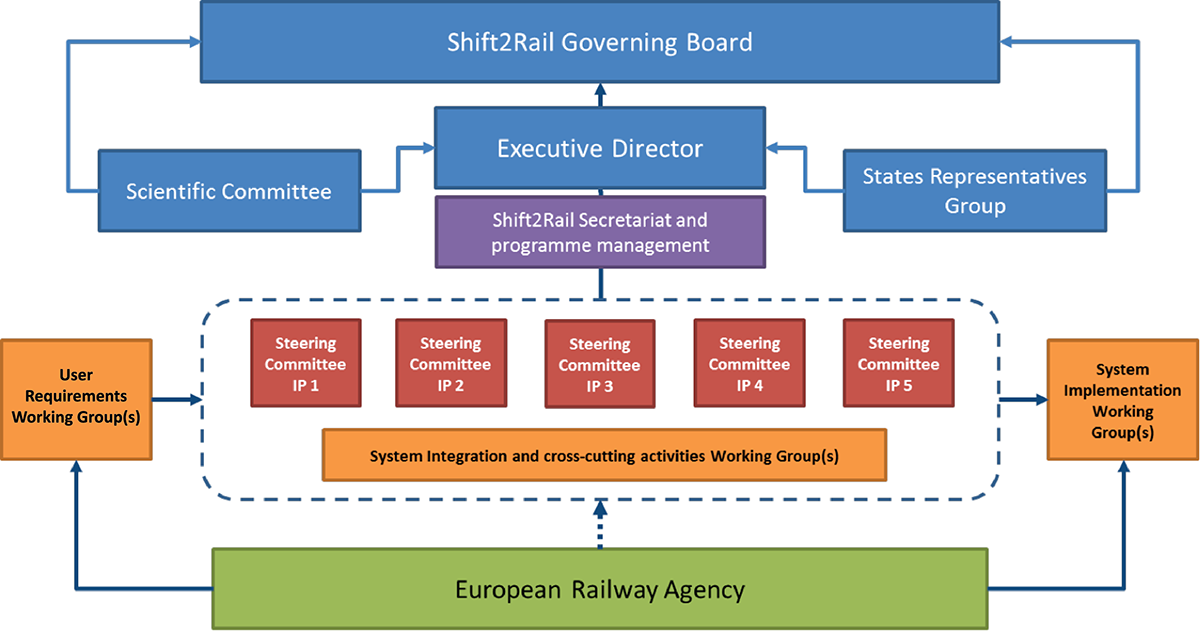Structure of Governance

Bodies defined by the Shift2Rail Statutes
The Shift2Rail Statutes envisage the Shift2Rail Joint Undertaking (JU) comprising the following four main bodies.
- The Governing Board, which has the overall responsibility for the strategic orientation and the operations of the Shift2Rail JU and supervises the implementation of its activities (Articles 6, 7 and 8 of the Statutes).
- The Executive Director, who is a member of staff of the JU and is responsible for the day-to-day management of the Shift2Rail JU. The Executive Director also manages the Shift2Rail Secretariat (Articles 9 and 10 of the Statutes).
- The Scientific Committee, which will advise on the scientific and technological priorities to be addressed in the Annual Work Plans (AWPs). This committee is to comprise world-renowned scientists and provide scientific expertise and science-based recommendations to the Shift2Rail JU. It is appointed by the Governing Board, taking into consideration the potential candidates proposed by the States Representatives Group, the European Rail Research Advisory Council (ERRAC) and the European Union Agency for Railways (ERA) (Article 13 of the Statutes).
- The States Representatives Group, representing EU Member States and countries associated with the Horizon 2020 Framework Programme; inter alia, this group will offer opinions on the strategic orientations of the JU and on the links between Shift2Rail activities and relevant national or regional research and innovation programmes (Article 14 of the Statutes).
The Scientific Committee and the States Representatives Group are advisory bodies to the Shift2Rail JU.
In addition to these four bodies, the Statutes also foresee the following.
- A specific advisory role for the European Railway Agency in contributing to the definition and implementation of the Shift2Rail Master Plan and to the Annual Work Plans (AWPs), and ensuring that the R&I activities of Shift2Rail lead to technical standards with a view to guaranteeing the interoperability and safety results (Article 12 of the Statutes).
- The establishment of the IP Steering Committees, comprising representatives of the founding members and associated members, as well as of the Shift2Rail Programme Office, in charge of the technical input and the implementation for each IP (Article 11 of the Statutes).
- The possibility of creating a limited number of working groups to assist the JU in carrying out its tasks. These working groups should comprise experts and work in a transparent manner. They should ensure the widest range of expertise and facilitate the participation of small and medium-sized enterprises (SMEs), research organisations and actors from outside the traditional rail sector (Article 15 of the Statutes).
Working Groups
Shift2Rail objectives include promoting an inclusive approach to the widest range of relevant stakeholders, but also ensuring that the Shift2Rail programme pursues a system-wide approach, ensuring the necessary coordination across activities and sufficient focus on end-user needs. With a view to ensuring that the Shift2Rail fulfils these objectives, the Executive Director established the following working groups:
- a User Requirements Working Group for each Innovation Programme (IP), to specify operational and maintenance-related user needs and to assist the JU in ensuring that technical solutions developed within Shift2Rail meet the specific business needs of end users;
- a System Integration Working Group (and if appropriate, System Integration Subgroups), to ensure coordination between the activities of each IP and to assist the JU in ensuring that the cross-cutting themes are properly mainstreamed across all IPs;
- an Implementation and Deployment Working Group (and if appropriate, Implementation and Deployment Subgroups), to test the operational reliability of the results of Shift2Rail, and with a view to assisting the JU in ensuring the rapid uptake and large-scale deployment of solutions developed through Shift2Rail activities.

